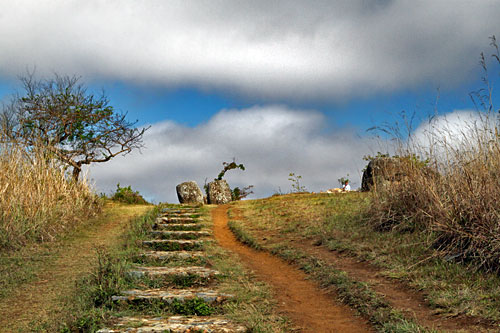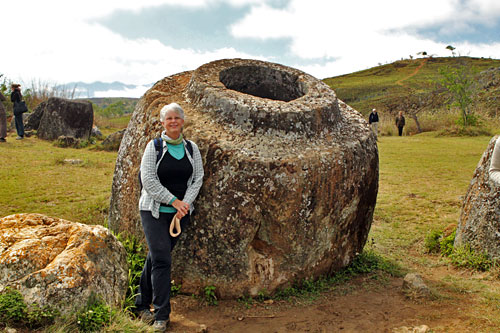I gazed down on hundreds of giant stone vessels scattered across the fertile Plain of Jars and thought of ants. Some lay crazily canted, as if abandoned in haste by an ancient race of giants whose dinner had suddenly been interrupted by invaders. Like ants to whom humans are invisible, I imagined that the jars were used by giants too large to be perceived by humans. Were they drinking glasses for these behemoth creatures? Or perhaps dollhouse dinnerware for an adolescent giantess?

Though theories abound, no one knows for certain who made the jars, what they were used for, or how old they are, although they are thought to be up to 2,500 years old. Carved by hand from solid rock at sites in the distant mountains, these enormous limestone, granite and sandstone vessels were somehow transported to their current location near the town of Phonsavan in east central Laos. Their placement near the ancient trading route known as the Silk Road has led some experts to speculate that they held grain or lao-lao, a potent local liquor made from rice. Others believe they were used to capture and store rainwater in this semi-arid landscape. Indeed, except for the materials from which they are made, the ancient jars bear a striking resemblance to klongs, giant clay pots still used today throughout rural areas of Southeast Asia to store water. Today the most widely accepted theory is that they were funerary urns, though none I saw exhibited the ornate carvings or decorations normally associated with ancient burial rituals.

On the top of the hill I posed for a photo beside the largest of the jars, a fat round container measuring 8.2 feet in diameter and 8.4 feet high. Whatever its use, the jar was not intended to be moved; nothing short of a crane could budge it and its sheer enormity seemed to preclude storage, since and foodstuffs at the bottom would have quickly moldered. I wandered among the 334 jars at Site 1, enchanted by the lush green hills and rich red soils that provided an exquisite backdrop, half expecting a giant hand to reach down from the sky to take up its drinking glass at any moment.
The most challenging part of my visit was the need to stay on the trail. Between 1964 and 1973, the United States dumped four billion pounds of cluster bombs on Laos in a “secret war” against Pathet Lao and North Vietnamese communists, the largest portion of the bombings being conducted in this area of Laos. A huge percentage of the bomblets failed to explode and they still lie buried under a shallow layer of topsoil, waiting to be inadvertently triggered. Fortunately, unexploded ordnance (UXO) has been removed from Site 1 and visitors are safe, as long as they stay between white stones that mark cleared areas. I desperately wanted to take a closer look at caves in the hillsides and red bomb craters that still pock the gently rolling hills after all these years, but I dared not.
Can’t see the above slide show of the Plain of Jars in Phonsavan, Laos? Click here.
Thousands of the vessels have been discovered at more than 90 sites in the Plain of Jars. Whether they held trading foods, water, or human remains may never be known for sure but the mystery of their creation and use provides rich fodder for the imagination. On my final day in Phonsavan I met a local teacher who told me of a Lao legend about a race of giants who inhabited the area at one time. It seems I am not the only one with an overactive imagination.

Six years after this original post, I’m reading it and being reminded that Loas is one of those countries I’ve always been drawn to. I think it’s time to plan a trip.
Hi Dru: If you have the opportunity, I highly recommend Laos, especially Plain of Jars and Luang Prabang. Good to hear from you, BTW. xo
Really cool article and great photos, very intriguing stuff! Certainly you made my wanderlust spark up! muchos gracias
I’ve always heard about the Plain of jars – but I never knew what it was about! And this is the first time I’ve ever seen pictures! Absolutely amazing!
This looks like an amazing experience!
I’m dying to visit this site. So fascinating!
they’re humongous.. ive read about them but ive never seen them… im puzzled with what those jars are for…
This was fascinating. The name Plain of Jars struck a bell somewhere at the back of my mind, but I couldn’t remember from where. I had no idea that it refered, literally to jars! I just presumed it was a “foreign” word which sounded the same as the English word. I’ve never read anything about this area before, so this was especially interesting for me, and the landscape nothing like I imagined Laos to be. Loving learning through your journeys!
Hi Linda: Phonsavan and the Plain of Jars were fascinating and more than a little sad for me, as I was confronted by the issue of the “secret war” that was fought here during the Vietnam era, when my country illegally and secretly dumped tons of cluster bombs. Hundreds of thousands of unexploded bombs remain buried beneath the topsoil, resulting in loss of life, limb, and eyesight for hundreds of people each year, many of them children. I was appalled that I didn’t know about it previously and even more disturbed that we’re doing nothing to help remediate the situation, which has kept this beautiful country in abject poverty because no development can occur unless the land is cleared of bombs. More about it in an upcoming post.
Barbara, that was a beautiful post about a poignant experience. I also felt that American guilt when I visited the Plain of Jars last year. Living here in Laos has taught me so much about my own country’s history. Amazing what we DIDN’T learn in school! Enjoy your wonderful travels!